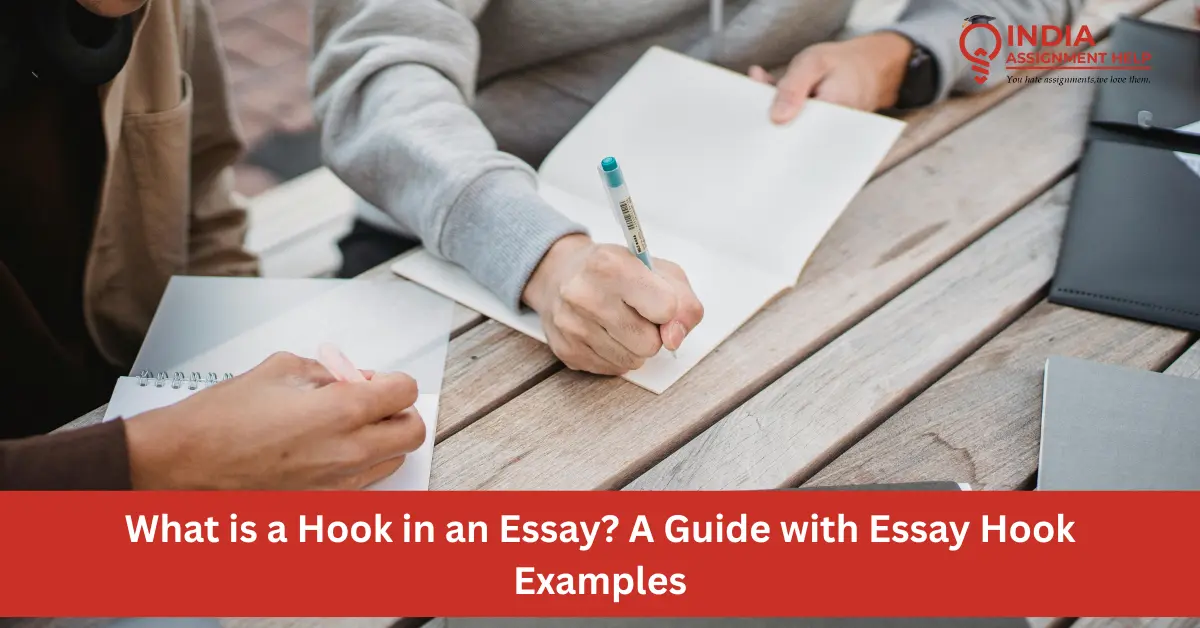What is a Hook in an Essay? A Guide with Essay Hook Examples

Every essay starts with a blank page, a deadline, and a topic that could go either way. The first thing you need to write a perfect essay is a spark. That spark is your hook. A hook is the opening line that stops a skimming reader and makes them stop and lean in. It’s small, but it carries big weight. Every university student in Malaysia is required to write an essay. But one big mistake they make is following the same old template and starting their essays like “In today’s day and age.” Professors read multiple essays every day, and they get thrown off when they read the same boring opening line at the start of every single one of them. That’s why a hook is important. It makes them wait and think, “This one seems interesting.” In this blog, we’ll discuss what essay hooks are with clear examples.
What Is a Hook in an Essay?
The hook is the first sentence (or two) designed to attract curiosity and set the tone of an essay. It doesn’t talk about the entire essay but just hints at the whole conversation to come. When done right, it nudges readers to keep going without forcing them.
There are different types of hooks and different ways to write them, too. You can’t use one type of hook for all your essays. There’s a science behind using hooks, too, and this blog will help you understand it.
Why Hooks Work and Why They Matter
Readers make micro-decisions every second. Your first line either catches their attention or makes them mentally check out. A strong hook works because it adds momentum to your introduction. It invites questions and frames context.
Hooks also reduce your writing anxiety. Once you land a good opener, the rest of the paragraph flows more naturally. A hook matters not just because it grabs attention but also because it makes your writing more impactful and persuasive.
According to our assignment help experts, a good hook:
- Sparks curiosity
- Highlight your voice
- Structure your argument or story
- Leaves a good impression
How to Write a Great Hook
Every memorable hook is made by a blend of three things, which creates a gap in the reader’s knowledge that they want to close.
One-line formula to write a good hook:
Hook = Specific Spark + Implied Tension + Clear Direction.
You don’t need all three every time; just analyze your topic and style and evaluate which one of these you want and in what proportion. Below, we’ve discussed examples that’ll make it easy for you to understand how to apply this formula when you’re writing a hook.
8 Essay Hook Examples and Types
1) Start with a Shocking Statistic
Newspapers often use these hooks to grab attention. Start with a statistic about your topic that is unheard of.
For Example:
“Every minute, the world dies a little because of plastics, and yet 90% of households still use them.”
Why it works: This offers readers a mix of precision and surprise, which signals urgency to them. This type of hook is great for expository and cause-and-effect essays.
2) Ask a Disarming Question
You can always start your essay with a question, as they activate curiosity immediately. The readers immediately want to read more of your writing to get answers.
For Example:
“If your phone tracked every micro-decision, you made today, would you still call it smart—or invasive?”
When you use this type of hook, make sure to keep it answerable later in the essay.
3) Paint a Vivid Scene
A scene makes abstract issues feel human, and that’s why anecdotal hooks have been working for years.
For example:
“The classroom hums, but Aisha’s laptop buffer spins, and the scholarship portal times out again.”
One moment of your little anecdote can carry the whole theme. It is perfect for narrative and reflective pieces.
4) Borrow a Credible Quote
Quotes can be a great way to start your essays, but only if they fit your theme. The trick here is to avoid clichés that everyone uses and aim for relevance over fame.
For Example:
“‘What gets measured gets managed,’ Drucker warned, but what if we’re measuring the wrong goals?”
5) Begin with a Micro-Conflict
Conflict compels reading. These hooks work because readers get interested when they hear someone has an unpopular opinion about a topic they’re interested in and jump into reading either to support or oppose your argument.
Example: “The cafeteria banned energy drinks, and why it was a good decision”
It’s always good to start with a friction point and resolve it through your argument.
6) Data Gap Hook
Revealing missing information about your essay topic can also be a great start, as curiosity spikes when data is scarce. It promises the readers that your essay fills the gap.
For example:
“No one tracks the long-term mental health effects of overworking on new hires.”
7) Hypothetical Scenario
In this type of hook, you invite the reader into a situation. It can be used to discuss serious topics by anchoring them to real trends.
For example, “Imagine your medical test results arrive by chatbot: accurate, instant, and emotionally tone-deaf.”
8) Clean, Bold Statement
Short bold statements make readers think you’re confident about your opinions, but it is also necessary to support your statement with evidence afterward.
Example:
“Banning homework won’t fix learning; better feedback will.”
Many students take the help of essay helpers to choose the right hooks for their essays.
Hook Sentence Examples for Argumentative Essays
Argumentative writing thrives on tension. Your hook should reveal friction, stakes, or a fresh angle. Let’s take a look at hook sentence examples for argumentative essay openings you can adapt.
- Provocative Claim: “University rankings harm students more than they help.”
- Counterexample: “If social media inevitably ruins attention, explain long-form podcasts.”
- Value Clash: “Public safety and personal privacy aren’t enemies; lazy policy makes them fight.”
- Cost–Benefit Turn: “Banning fast fashion feels moral until you price the alternatives for single parents.”
- Hidden Assumption: “We tax sugar to improve health, yet ignore the neighborhoods without grocery stores.”
- False Dilemma Bust: “Remote work isn’t all or nothing; it’s a menu, and teams should choose the dish.”
- Stat & Challenge: “One in five teens reports anxiety, but school calendars still mirror factories—why?”
- Micro-Story: “The library closed at 6; the scholarship form closed at 7; Jamal chose dinner.”
Each line sets up debate space and also nudges the thesis into a specific direction. After the opening hook, follow with context, define terms briefly, and land your position to write an effective essay.
Common Hook Mistakes to Avoid
Most students make the same mistakes while writing hooks. Let’s see what those are and how you can avoid them.
Avoid Clichés: Clichés drain the energy of your readers before you begin. Instead, you can use statistics and data trends related to your topic.
Overpromising Mistakes: When you overpromise through your hook but underdeliver, it makes readers distrust you. Always calibrate the claim so your evidence can carry it later.
Long quotes: Quotes only work when they’re short and relevant to the theme of your essay. It is advisable to trim quotes to one powerful line and add your voice immediately after.
Conclusion
Hooks are not magic; they can’t turn a poorly written essay into the most perfect one, but they can surely enhance it. A single, well-shaped line can lift your introduction and steady your voice. To write a perfect hook, you first have to be clear on the purpose and theme of your essay, choose a hook type that fits best, and then follow up with your voice to add context. A hook is the quiet start to a strong essay. We hope all your questions regarding essay hooks are answered now. If there’s any query, you can reach out to our essay help service, and we’ll assist you with your writing needs happily.





